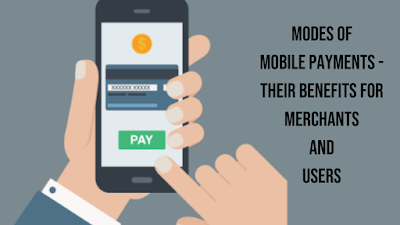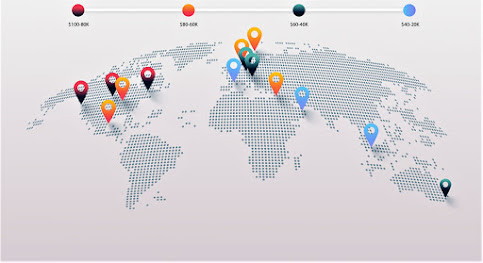Modes of Mobile Payments - Their Benefits for Merchants and Users
In this era of technological advancement, the world is moving rapidly towards digitalization. But when you particularly talk about the banking and finance industry, Android E-wallet app development and E-wallet app for iphone is the hottest topic worldwide.
Based on a research by The Business Research Company, the digital payment market is predicted to grow from $5058.96 billion in 2020 to $5872.89 billion in 2021 with an annual growth rate of 16.1%. Moreover in 2025, the market is expected to reach $9073.09 billion with a Compound Annual Growth Rate (CAGR) of 11%.
Now, let’s move towards the modes of mobile payments, and their benefits for merchants and users.
Modes of Mobile Payments
1. Digital Wallets
These wallets can be accessed through smartphones, computers, or tablets. Digital wallets users can store the information of their bank accounts and credit cards within the application. It also allows users to make payments directly from those cards and accounts.
2. Mobile Wallets
Mobile Wallet is a virtual wallet that permits businesses and individuals to make payments and receive money using their mobile devices. You can also store debit and credit card numbers in these wallets which can be used to make direct payments. Mobile wallets are accessible through the app installed on the user’s mobile device including a tablet or a smartphone. Mobile wallets work similarly as digital wallets, but the app is exclusively for mobile phones. Mobile wallets can facilitate payments for online as well as in-store purchases.
These wallets are of three types -
Open wallets
An open wallet permits users to use the wallet’s funds to make payments for transactions or withdraw the funds deposited to the account in cash. These types of wallets can be used through a third party or directly by a bank. PayPal is one of the best examples of an open mobile wallet. It enables users to make payments for in-store, online purchases, and transfer funds.
Closed wallets
In closed wallets, users cannot use the money for making payments with any merchant and third-party service providers, and even they can’t withdraw the funds in cash. These wallets are linked to specific merchants only, and users can only use the funds to make payments initiated with the particular merchant. Mostly independent sales organizations, online retailers, E-commerce service providers, and multi-tier organizations need these closed wallets. The best example of a closed wallet is Amazon Pay.
Semi-closed wallets
Semi-closed wallets are used to pay affiliated merchants in return to the purchase of goods and services, to transfer money between users, and many more.
These Wallets have a specific contract with the issuer to accept the payment instruments. Still, it does not permit cash withdrawal or redemption by the holder that enables the procuring of goods & services, which consist of financial services at a group of clearly recognized merchant locations/ establishments.
3. USSD based Payments
USSD aka, Unstructured Supplementary Service Data. It is a protocol used by GSM (Global System for Mobile Communication) networks to establish communication with the service provider. This mode of mobile payments have gained popularity in several many developing countries, specifically in Africa, where only 39.3% of the population use the internet. The Core reason behind the popularity of USSD payments is that they can be accessed from any cellular phone. Usually, users would type a particular USSD code that starts with an asterisk (*) and ends with a hash (#). The best example of USSD-based mobile payments is Vodafone’s M-Pesa.
4. Direct Carrier Billing
Users can pay for utilities with this payment method by paying via their smartphones. The users don’t need mobile phones to make payments through direct carrier billing, as it can be done through feature phones. It is the best payment option for those customers who neither use mobile phones nor has a bank account, making this option highly democratic in terms of financial inclusion. The customers using the direct carrier billing payment method would only need a subscription to a prepaid mobile phone.
Benefits for Merchants
Nowadays, if you have a small business or startup and still don’t accept mobile payments, you should start accepting them now because many people across the globe have started using mobile payments. Even almost half of the adults use mobile payments in the UK. Furthermore, around 53% of millennials want to manage their loyalty reward points by themselves, indicating that people are more likely to pay through mobile payment technologies. The following are the benefits of mobile payments for merchants:
1. Improved Customer Experience
If your app provides different payment options to the users, they always love choices and enjoy a hassle-free checkout experience. In the UK, 80% of the retailers believe that the mobile payments option improved their customer retention.
Payment through mobile devices reduces the checkout time and leaves users with time to interact more. For better customer retention, your app can provide them a variety of options to pay while shopping online. So, that they can pay, however, they want.
2. Increased Consumer Spending
In the USA and UK, mobile payment users spend twice the money as compared to the cash payers. Moreover, industry experts also believe that mobile wallets will phase out credit cards in the upcoming days.
Benefits for Users
1. Convenience
Carrying cash and physical cards is inconvenient and risky. Mobile payments and financial technologies will naturally grow to ease the customer shopping experience as mobile phones become all-in-one devices and almost everybody carries them along. This will help your customers never run out of cash, and they will never be required to carry a physical wallet.
2. Budgeting
Those days are gone when budgeting expenses used to be done manually. Mobile payments solutions offer the users a transaction history feature, allowing them to access all the transactions they have done in the past.
Conclusion
Indeed, E-wallets have undoubtedly transformed the FinTech market. Digital payment apps have made it simpler and faster to transact online and offline. Therefore, the E-wallet app for android and iOS will continue to stay in the market for a long time.




Comments
Post a Comment